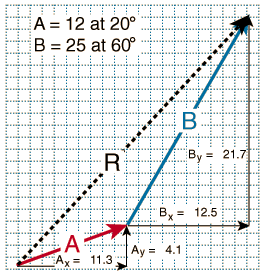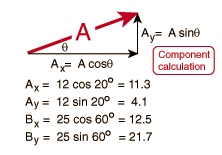This is unlike scalar quantities, who only have one value, such as time, mass, or length.
Those kinds of quantities are much less interesting.
When adding vectors, you add from the tail of the first to the head of the second. A third vector is created from adding two vectors of different length and direction.
 The same rule applies to when adding multiple vectors.
The same rule applies to when adding multiple vectors.When the vectors share the same origin, the resulting vector is the diagonal of the parallelogram formed by the original vectors.
When adding vectors A and B to equal R, R's coordinates are (a1+b1,a2+b2).

Example of Vector Components
| Index Vector concepts | ||
| Go Back |
For vector R, where a=ix and b=jy, and magnitude of R=||R||, then
In the case of the above R,
When subtracting vector B from vector A, multiply B by -1 and then add the resulting vector to A.
Stay classy.
-Noah

 The vector sum can be found by
The vector sum can be found by
No comments:
Post a Comment